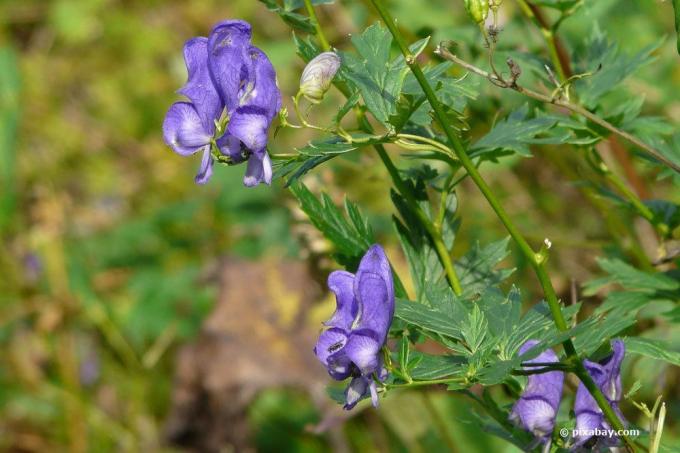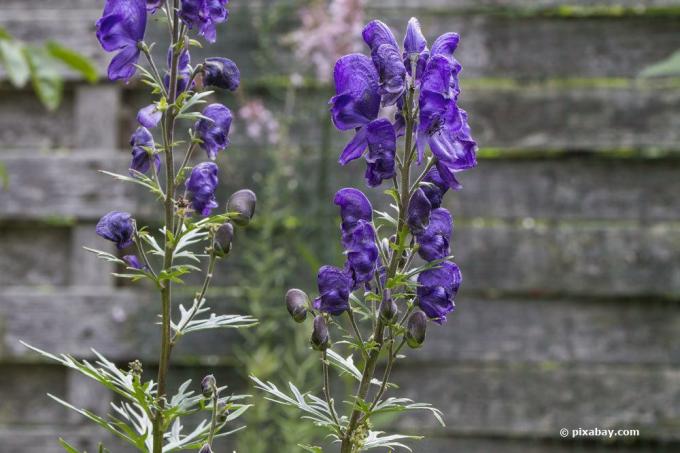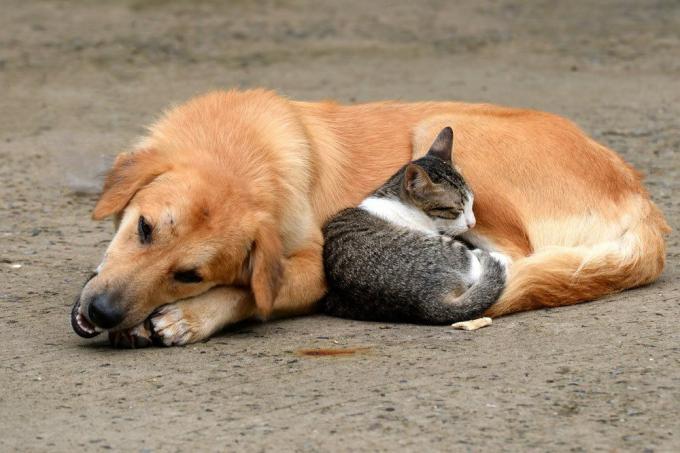
table of contents
- Toxicity
- Occurrence
- Toxic effect - human
- Toxic effect - animal
- Medicinal plant
- First aid measures
One of the most poisonous plants in Europe is the blue monkshood. It was not infrequently used as a murder weapon in the past. It only takes a few hours before death sets in when the plant is ingested.
Toxicity
Why is the blue monkshood so poisonous?
The strong poisonous effect of the plant is due to the contained therein Aconitine. The substance is absorbed through the skin when the plant is touched. However, touch is usually not fatal to humans. However, a rash does develop that clearly shows the plant's strong response to humans.

Occurrence
Where does the blue monkshood grow?
The poisonous plant is mainly found at higher altitudes from around 2500 meters. It can also occasionally be found on pastures. Its home and distribution extends across Central and Western Europe. Some specimens are also native to Sweden. In spite of its toxicity, the monkshood is one of the popular garden plants and - provided that you are knowledgeable - it is often grown there.
Toxic effect - human
How does Monkshood affect people?
As the most poisonous plant in all of Europe, extreme caution is required when handling the plant. Aconitine is contained not only in the tubers, but in all parts of the plant, which has a fatal effect on many living things. Just a few grams of the plant can kill an adult. Children in particular are at risk because even a tiny amount is enough to cause serious damage to their health.
The following symptoms occur:
- Symptoms begin with tingling sensations in the extremities
- Tingling in the mouth
- profuse sweats with nausea and vomiting
- painful intestinal colic, severe diarrhea
- after 20 minutes the body temperature drops rapidly
- after 30 minutes the blood pressure drops, the heartbeat becomes irregular
- severe poisoning leads to death within 30-45 minutes
- death occurs from heart failure

Toxic effect - animal
How does monkshood work in animals?
Ingestion of the plant is life-threatening and untreated, not only in humans, but also in animals. The following animals are toxic to the consumption of the plant.
- Farm animals such as horses, cows and cattle
- Pigs, sheep
- Pets like guinea pigs, hamsters, rabbits and hares
- Pets like cats and dogs
- all bird species

These symptoms indicate poisoning in the animal:
- excessive salivation and an enlarged pupil
- inner excitement, restlessness, aggressiveness
- Seizures, increase in body temperature
- Disturbances in the heartbeat and incipient paralysis of the face
- Death occurs from respiratory paralysis
In a dog, death occurs as soon as five grams of plant are eaten. Amazing: goats do not react to the consumption of blue monkshood with symptoms of poisoning, but they usually do not eat it.
Medicinal plant
Use in medicine
Although the plant is so poisonous, it is a popular medicinal herb and is used regularly. Aconitine is mainly used for rheumatism, pleurisy and nerve pain. Homeopaths use the plant for inflammation of the pericardium and bronchitis.

First aid measures
Treatment of poisoning
All parts of the monkshood are poisonous, so that contact and subsequent symptoms should always lead to contact with the doctor. The poison control center must also be notified. To date, there is no antidote to the active ingredient, however, under intensive medical care, death can possibly be prevented.
The most important measure is to maintain cardiovascular function; artificial ventilation may be necessary. Irrigation of the stomach can also be helpful, and dialysis is sometimes used. Because the plant is extremely poisonous, some people die of heart failure despite medical treatment. The risk of rapid death correlates with the amount of poison ingested.
